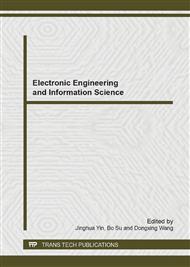[1]
Mrigank Sharma, Elie H Sarraf, Edmond Cretu. Parametric Amplification/Damping in Mems Gyroscopes[C]. MEMS 2011, Cancun, Mexico, 2011: 617-620.
DOI: 10.1109/memsys.2011.5734500
Google Scholar
[2]
Hongzhi Sun, Kemiao Jia, Xuesong Liu, Guizhen Yan, Yu-Wen Hsu, Robert M. Fox, Huikai Xie. A CMOS-MEMS Gyroscope Interface Circuit Design With High Gain and Low Temperature Dependence[J], IEEE Sensors Journal, 2011, 11(11): 2740-2747.
DOI: 10.1109/icsens.2010.5690797
Google Scholar
[3]
S. Sonmezoglu, S.E. Alper, and T. Akin, An Automatically Mode-Matched Mems Gyroscope With 50 Hz Bandwidth[C], MEMS 2012, Paris, France, 2012: 523-526.
DOI: 10.1109/memsys.2012.6170231
Google Scholar
[4]
Chunhua He, Qiancheng Zhao, Jian Cui, Zhenchuan Yang, Guizhen Yan, A Research of the Bandwidth of a Mode-Matching MEMS Vibratory Gyroscope[C], NEMS 2012, Kyoto, Japan, 2012: 738-741.
DOI: 10.1109/nems.2012.6196880
Google Scholar
[5]
J. Seok, H. F. Tiersten, H. A. Scarton. An Analysis of a Vibratory Angular-rate Gyroscope Using Polarized Piezoceramic Bimorph Plates[J]. Part 2: Solution Procedure for the Gyroscope with Superposed Angular Velocity. IEEE Sound and Vibration. 2005, 280(1-2): 289-310.
DOI: 10.1016/j.jsv.2003.12.031
Google Scholar
[6]
T. Rogers, N. Aitken, K. Stribley, J. Boyd. Improvements in MEMS Gyroscope Production as a Result of Using in Situ, Aligned, Current-limited Anodic Bonding[J]. IEEE Sensors and Actuators. 2005, 123-124: 106-11.
DOI: 10.1016/j.sna.2005.03.009
Google Scholar
[7]
W. A. Clark, R. T. Howe, R. Horowitz. Surface Micromachined Z-axis Vibratory Rate Gyroscope[C]. Tech. Dig. Solid-state Sensors and Actuators Workshop. Los Angeles, United States, 1996: 283-287.
DOI: 10.31438/trf.hh1996.64
Google Scholar
[8]
X. Xiong, D. Lu, W. Wang. A Bulk-micromachined Comb Vibratory Microgyroscope Design[J]. Circuits and Systems. 2005, 1(7) 7: 151-154.
DOI: 10.1109/mwscas.2005.1594061
Google Scholar
[9]
McCluskey, P., Lemus, D. Performance and reliability of mems gyroscopes at high temperatures[C]. Thermal and Thermomechanical Phenomena in Electronic Systems (ITherm). 2010: 1-5.
DOI: 10.1109/itherm.2010.5501319
Google Scholar


